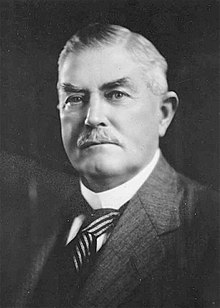George Fuller (Australian politician)
Sir George Fuller | |
|---|---|
 Portrait of Fuller | |
| 22nd Premier of New South Wales Elections: 1922, 1925 | |
| In office 20 December 1921 – 20 December 1921 | |
| Monarch | George V |
| Preceded by | James Dooley |
| Succeeded by | James Dooley |
| In office 13 April 1922 – 17 June 1925 | |
| Preceded by | James Dooley |
| Succeeded by | Jack Lang |
| Personal details | |
| Born | 22 January 1861 Kiama, New South Wales |
| Died | 22 July 1940 (aged 79) Darlinghurst, New South Wales, Australia |
| Political party | Nationalist Party of Australia |
| Spouse | Ada Louisa King |
| Education | Sydney Grammar School University of Sydney |
| Profession | Lawyer |
Sir George Warburton Fuller KCMG (22 January 1861 – 22 July 1940) was Premier of New South Wales, Australia on two occasions during the 1920s. His first term of office lasted less than one day (20 December 1921); his second lasted from 13 April 1922 to 17 June 1925.
Early life
Fuller was born in Kiama, New South Wales and was educated at Kiama Public School, Sydney Grammar School and at St Andrew's College at the University of Sydney. He received a Bachelor of Arts (Hons) in 1879, and a Master of Arts in 1882 from the University of Sydney. He studied law under Sir William Patrick Manning (eminent judge and university chancellor) and became a barrister in 1884.[1]
Political career
Fuller served in the New South Wales Legislative Assembly for over 18 years. Initially he represented Kiama from 1889 to 1894, but was defeated in 1894 and again in 1898.[2]
Fuller was the first member for Illawarra in the new Australian House of Representatives between 1901 and 1913. He was Minister for Home Affairs in 1909 and 1910 in Alfred Deakin's Commonwealth Liberal Party government and was responsible for making Canberra the national capital. In 1911 he was an Australian representative at the coronation of George V.[2]
Return to State politics
From 1915 to 1928 Fuller represented Wollondilly for the Liberal Party and, from 1916, the Nationalist Party. In part of 1916 and 1917 he was leader of New South Wales' Nationalist Party and he became Colonial Secretary (the second most important cabinet position) in 1916. In 1917 his heavy-handed handling of a strike by rail and tramway workers against the introduction of time cards antagonised the unions and led to a general strike. His promise of higher pay and improved seniority benefits to workers returning to work split the rail unions for most of the twentieth century and the different employment conditions lasted until the Lang Government was elected. His action were seen by supporters as the decisive leadership required in wartime. In 1919, he expanded the state-owned fishing trawler fleet "to provide cheap fish for the mass of the population".[2] On 3 June 1919 he was appointed as a Knight Commander of the Order of St Michael and St George for his service as Colonial Secretary.[3]
Labor won the 1920 election and Fuller became Leader of the Opposition. In 1921 he took advantage of the death of John Storey to defeat James Dooley's Government on a motion of no confidence and as a result was asked to form a government. But Fuller himself had to give up the Premiership after only seven hours, after losing another motion of no confidence and Dooley returned to office.[2] In the 1922 state election, Dooley was defeated and Fuller became Premier once again. His government began the construction of the Sydney Harbour Bridge. This time his tenure lasted till the 1925 state election, won by Labor's Jack Lang.
Shortly after Lang's victory, Fuller resigned from the Nationalist leadership in favour of Thomas Bavin. From 1928 to 1931 he was the state's Agent-General in London. He died in the Sydney suburb of Darlinghurst.[2]
Notes
- ^ "Sir George Warburton Fuller (1861–1940)". Members of Parliament. Parliament of New South Wales. Retrieved 8 February 2010.
- ^ a b c d e Ward, John M. (2006). "Fuller, Sir George Warburton (1861–1940)". Australian Dictionary of Biography. Retrieved 8 February 2010.
- ^ Knight Commander of the Order of St Michael and St George, KCMG, 3 June 1919, itsanhonour.gov.au
Citation: Colonial Secretary of New South Wales
- 1861 births
- 1940 deaths
- People educated at Sydney Grammar School
- University of Sydney alumni
- Members of the Australian House of Representatives for Illawarra
- Members of the Australian House of Representatives
- Members of the Cabinet of Australia
- Free Trade Party members of the Parliament of Australia
- Commonwealth Liberal Party members of the Parliament of Australia
- Australian federationists
- Nationalist Party of Australia politicians
- Australian Knights Commander of the Order of St Michael and St George
- Premiers of New South Wales
- Members of the New South Wales Legislative Assembly
- Australian diplomats
- Leaders of the Opposition in New South Wales
- Treasurers of New South Wales

